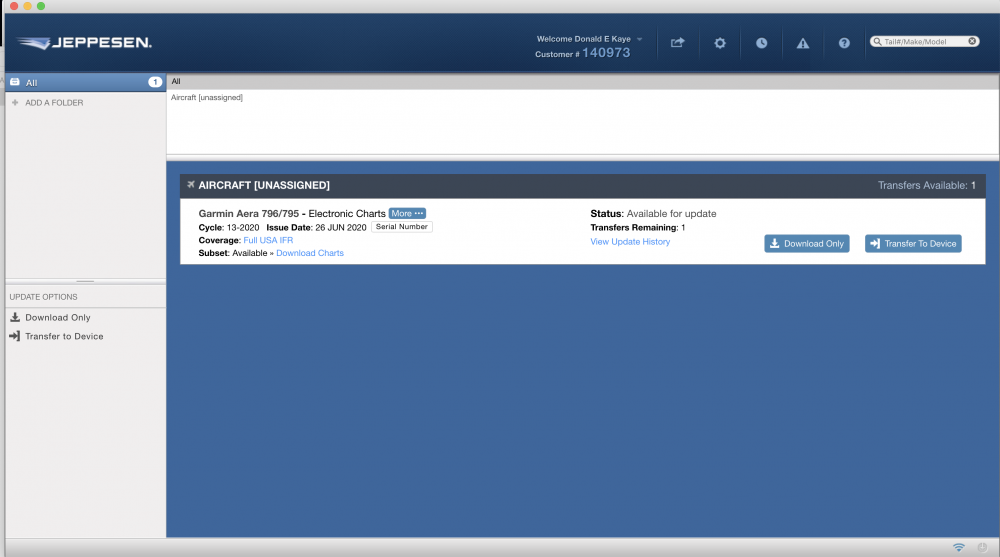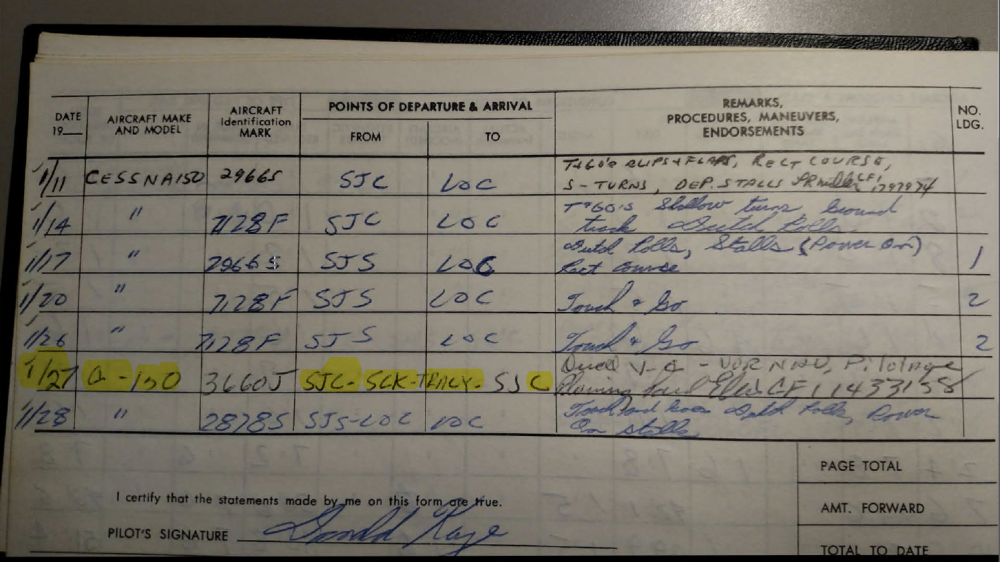-
Posts
2,554 -
Joined
-
Last visited
-
Days Won
32
Content Type
Profiles
Forums
Blogs
Gallery
Downloads
Media Demo
Events
Everything posted by donkaye
-
This is how I have mine set up. http://www.donkaye.com/donkaye.com/Battery_Minder_Setup_for_the_Mooney_TLS.html
-
So, Paul, you are actually flight instructing?
-
If I were the FAA, this pilot would have his license revoked and, if a fine is possible, fined to the max. His anti-authority attitude makes it even worse. Looking at his position in the Airspace, he endangered other people. The Controller should be commended for keeping her cool as well as she did. You are not entitled to enter Class Bravo Airspace. In fact, most times when asking for a clearance into a Bravo, it is denied for small planes. Even on an IFR flight plan, as a small GA airplane, I am vectored around it in the Bay Area. This pilot is a disgrace to the GA pilot community, and the Henderson Controller should be ashamed of himself for apologizing to him.
-

Garmin AREA 760: Disappointing experience
donkaye replied to Oscar Avalle's topic in Avionics/Panel Discussion
In my case I fly many, many airplanes. If you want a Garmin handheld, you have no options but to use a Garmin receiver. -

Garmin AREA 760: Disappointing experience
donkaye replied to Oscar Avalle's topic in Avionics/Panel Discussion
I think it is a matter of preference and what you feel most comfortable with. Step downs are better documented on Jepp Charts, but there is a nice airport diagram on the Garmin NOS Charts. I watched a webinar on the 760 and some other products. I asked about Jepp Charts, and Garmin answered that they were available. I don't think these people knew what they were talking about. I do think they will become available at some point. -

Garmin AREA 760: Disappointing experience
donkaye replied to Oscar Avalle's topic in Avionics/Panel Discussion
Unless the airplane has a means of getting XM or ADS-B weather to the iPad or you bring along some type of receiver like the GDL 50 series to do it, the iPad is pretty useless for cross country flying where weather issues are involved. In flight instructing I'm often tasked to ferry airplanes around the country or help someone bring an older airplane home. They often have old avionics without weather capabilities. The Aera 796 allows me to "normalize" any airplane for travel around the country with weather and all other aviation specific tasks I need. I don't leave home without it. Of course I take an iPad for easy filing and briefing, but in flight the 796 is King. -

Garmin AREA 760: Disappointing experience
donkaye replied to Oscar Avalle's topic in Avionics/Panel Discussion
This isn't surprising, since to download the Jeppesen database for the Aera 796 with JdmApp, Jeppesen needs to enable your 796 for download. -

Garmin AREA 760: Disappointing experience
donkaye replied to Oscar Avalle's topic in Avionics/Panel Discussion
If the 796 Charts would work and you buy a key for the iPad, the Charts should be an additional $60, as a bundle. At least that was the way it was last year. The US coverage for the iPad was $199 last year. With Boeing having bought Jeppesen, who know what is is today. Worth a try for $60, if you have an iPad subscription. I'm a gadget guy, too, and have bought nearly every Garmin handheld since they came out with the GPS 90. I like the features of the 760, but having to buy the bulky GDL 51 for XM weather, and potentially no Jeppesen interface is a complete deal breaker for me. I'll be passing on this unit---for now. -
Good find! I posted last last night and should have looked it up myself. 54 years and still going strong. I bet it has some history going for it. Ironically, I left San Diego for the Bay Area, and it left the Bay Area for San Diego. It got the better deal.
-
Brings back memories... It was January 27, 1968; N3660J, a Cessna 150. 10 logbooks ago. I was working on my private and the instructor, Paul Ellis, a fireman at his day job, said we were going on the dual cross country even though it was a bad weather day. Being stupid at the time and relying on his experience, I agreed to go. We took off from San Jose and were going to Stockton. The 150 was real sloooow in the climb in which, due to weather, we climbed to 11,500 to get around some clouds. I remember him casually smoking his pipe in the hour long climb with the last 500 feet climbing at about 100 ft/min. We made it to Stockton. Then the real fun began. We visited the FSS that was on the field at the time (good old days). It didn't look good for the return. We took off on the way back to San Jose through what I now know was the Altamont Pass. As we approached the pass we hit really heavy rain and turbulence. Paul took the plane, rolled into a 60° bank and did a 180. We landed in Tracy. I wanted to kiss the ground. I told him I wanted to take the bus back to San Jose. He said, "No way" and that we could make it back. Against my better judgment, I got back in the plane and we took off. I watched Paul closely this time around. No casual smoking of a pipe; he was very intense. That gave me a whole lot of confidence. Right. Anyway, we did make it back in one piece with a lot of creaking of the 150's wing. Years later I saw what the ribs of the 150 wing were made of. You could easily bend them with you hands. It was the finished structure and support to the fuselage that held it together. 52 years and 11½ thousand flight hours later it's a different story. The Mooney wing is like no other, and I don't even give it a second thought to climb to 17,000 feet in 17 minutes in the Bravo.
-
Bob Kromer had it right and it applies to all model Mooneys. He discussed it at length at the last MooneyMax convention. Apply slight back pressure on the takeoff roll and the plane will fly off when it is ready. After it leaves ground effect, I trim slightly for hands off climb. Initial setting is dependent on CG. With 2 people in front I trim at the upper end of the takeoff range. With full load more towards the center. In either case from experience with my plane, I tend to trim slight higher than centered within the takeoff position to make it a little easier to break ground.
-

GTN visual approach with KFC 150
donkaye replied to Costa Leite's topic in Avionics/Panel Discussion
If there is an obstacle obstructing the 3° slope then no glideslope will be provided, only lateral guidance. If you're not in mountainous territory, most airports in the US provide a GP. Not sure about other countries. -

GTN visual approach with KFC 150
donkaye replied to Costa Leite's topic in Avionics/Panel Discussion
Anyone who's installed a 750 should know this, but it wouldn't hurt to ask them tactfully if they might have hooked it up wrong because you are not able to capture the GP with your GPS. -

GTN visual approach with KFC 150
donkaye replied to Costa Leite's topic in Avionics/Panel Discussion
It sounds like your 750 wasn't wired correctly. You should be able to fly LPV and visual approaches on the KFC 150 just like you fly an ILS approach. In the wiring there is a choice for LOC or LOC/GPS when it comes to capturing the glide path. Sounds like yours was wired for LOC and not the one that recognizes both. I waited to post this until I spoke with my avionics guys today while handling another matter associated with the new GTN 750Xi. They saved me from having to replace the new 750Xi after ATC kept telling me I came in broken and unreadable. Turns out the mic setting was set too low. Went flying and confirmed all was good. -
Two different models of airplanes. Possibly the problem.
-
Originally I had the KI256, then the G500 with GAD 43e. The KI256 was used in conjunction with the BK EFIS 40 and the older, but outstanding, KLN 90B. I skipped the GNS series of GPSs. Pre WAAS the GPSs had full scale deflection of 5 nm. The WAAS GPSs have 2 nm full scale. The reason this is important to say is because with my original setup the KFC 150 worked perfectly. If I had a WAAS GPS it may have had the problem that I am about to discuss. When I did my upgrade to the G500 with the GAD 43e In all modes other than GPSS I had wing rock that I spent thousands of dollars trying to get rid of. The higher resolution lateral navigation of the GTNs with the digital to analog interface was more than the KFC 150 could handle. I never did get rid of the wing rock. So, I can't say how it would have handled a WAAS GPS with the KI 256. All I can say is that it was totally unsatisfactory with the G500/GAD 43e interface. Luckily, I was in GPSS mode most of the time, and what a relief to get the GFC 500 autopilot.
-
Even if the GFC 600 were available today, I'd still go for the GFC 500. The GFC 600's parts alone are more than $10,000 more than the GFC 500 and its servos are overkill for our airplanes. I think a 4 servo installation would be over $40,000. Not necessary.
-
Several years ago Garmin told me they will not certify the GFC 600 for the Mooney. The KFC 230 still would use the heavy old BK servos, you have to have them all checked out as good before they will warranty them ($$$), when they do go bad they are very expensive to refurbish, and BK is just a plain unreliable company now. l just wouldn't consider the KFC 230. Also, a lot more if you wanted to add the YD servo. Getting rid of the GCU 485 later means another panel change and another couple of thousand dollars later like I had to pay. In my opinion you should do the GFC 500 now and enjoy it for now and not later. You'll save the cost of the GCU 485 and another panel cost.
-
Like I said above. Different Garmin shop locally this Thursday $$$. I should not have had to do this. The previous 750 worked just fine with the cables and antennas as they were.
-
I corrected it above. They were both Xi units that I was switching between. The 650 Xi was good, the 750 Xi was no good.
-
Your new panel looks great! A couple of questions: Why not do the upgrade to the GFC 500 now? It's the perfect time, and could be done for under $20K with sale of the ESI 500 and KFC 150 autopilot parts. If you did that, the only benefit of the GCU 485 would be easy access to Baro change. I found the GCU 485 to be very useful for the month before the GFC 500 got approved for the long body Mooneys. Had I known it would be approved so soon, I would not have put in the GCU 485. There is absolutely no comparison between the KFC 150 and the GFC 500. In addition to adding VNAV coupling capability, it has ESP and LVL, and it is such a smooth AP. Last weekend was very bumpy down low and the YD was just outstanding.
-
A little update on the GTN 750 Xi upgrade. I might have mentioned that the software is a little different in that there is a database icon on the startup screen to make updating easier. The screen resolution is so much better. With the regular GTN, when a Chart would zoom in during an approach it would become blocky and unreadable. With the Xi it remains clear. OTOH, the "simple" upgrade turns out not to be so simple for me. The touch screen is intermittent and the Comm transmitter is unacceptable to ATC. I had noticed the need to tap one icon a couple of times on the way home from the install and also an ATC complaint, but I didn't give it too much attention at that time. Last Saturday I flew for the first time in a month for over 3 hours doing approaches and a little cross country. I started getting complaints from every controller, 4-5 of them. I started running a test with them checking between the GTN 650 Xi and the 750 Xi. Every one of them said the 650 was great but the 750 was not. Being 3 hours away from the installer now becomes a problem. I've got to deal with Garmin not wanting to exchange for a new unit, and even before an exchange, needing to pay another avionics shop $$ to do a S/N ratio test on the present one or pay a restocking fee when a return becomes necessary. Even if that were to be OK the intermittent touch screen requires some type of fix or an exchange no matter what. This whole process has turned out not to be any fun.
-
Irrespective of the baggage door locking controversy, I don't understand why Mooney put the door opening and closing metal track on the rear of the baggage door. A twisting moment is easily induced with it placed there. If it had been placed on the front of the door, while the door could open, having it ripped off with a twisting moment would be a non issue.
-

Aspen 1000 Pro / EDM 900 / Garmin 795 compatibility
donkaye replied to RDuplechin's topic in Avionics/Panel Discussion
You don't want to here this, but... I had Bendix King Avionics for 20 years while they were the big Kahuna. I still think the KLN 90B was the best GPS of its generation. I bought my airplane partly because of their EFIS 40 that Mooney, who was always on the forefront of avionics in their airplanes at the time, certified for the M20M. But times change and I went with it. Being a former Electrical Engineer working mostly on displays and having dealt with interface issues many times, I wanted a package that all worked together without my having to wonder if all the components would work together. I was lucky to be a flight instructor who got to work with most equipment out there. My decision was easy. It was Garmin all the way. Say what you may, but dealing with the big Kahuna has many benefits, like product longevity, definitive interface compatibility, really good customer support, really good warranty handling, and new and beneficial products always coming to the marketplace. And I happen to like their uniform user interface. I can't believe how far avionics has come since I was a display engineer with Kaiser Aerospace and Electronics in the late 1960's, when one of the sections was working with an elementary CRT display that was basically a G5 with clouds, was very heavy, but still worked in the C 172 in which they tested it. Since everyone was a pilot there, that's when I went ahead and got my Private, too. A couple of years ago I took my long retired Section Manager for a ride in my newly upgraded airplane and we discussed how much we would have loved to have been able to design such remarkable equipment. Tech just hadn't progressed that far, yet. So I was lucky to be in on the beginning of it all, and even luckier that life worked itself out in such a way that I could afford to get what I think is the very best of the best today. From a user and former Engineer's point of view Garmin was the best way to go for me. I should have taken a picture of the latest upgrade to the upgrade to the upgrade after I got back from Oregon a couple of weeks ago with the newly installed 750Xi and 650Xi upgrade. I'll post one when I get down to the airport in the next few days. -

Hangar Rate Increased Based On CPI
donkaye replied to MooneyMitch's topic in Miscellaneous Aviation Talk
KSJC is having its first rate increase in about 3 years starting in July based on a 2.5% CPI. That amounts to $14/mo to me. I don't need to tell you what that means in terms of the overall cost of aircraft ownership.






